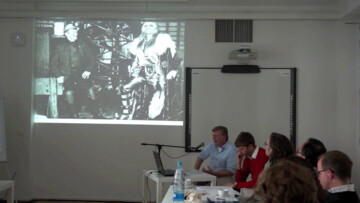Within the political-sociological-economic-historical field of ongoing modernity (roughly 1800 to the present day), capitalism reveals itself as a timeless, living and constantly changing and adapting, assimilating organism, that is in itself a key to the notion of the connection (not separation) of past and present. To make this visible with and within art a concept of critical analysis, of presentation, of exhibiting with and within → constellations emerged at the transition from the 19th to the 20th centuries as an appropriate tool to reflect, comprehend and work with a notion of “history” which is – as Walter Benjamin put it in his text entitled On the Concept of History [1] – a present which is aware of the fact that it is addressed by the past, which the respective present remembers in a brief moment, a flash of acute danger. This was put in strong contrast to the always ready, accurate “truth” of history that historicism claimed to achieve. Moreover, the concept of “constellation” was put forward by Benjamin as a strong counterpart and only logical alternative to the narration of history as a form of linear progress.
Thinking and working with constellations is the key to Jacob Burckhardt’s notion of history. He rejected in the mid-19th century the historical timeline of development, as well as the separation of historically relevant “fields” (the field of politics, the field of art, and so on) as an insufficient → construction. Instead, he saw the artistic wealth of innovations in the Renaissance, and its development of the ideas known as → humanism, existing at the same time as the political practices and barbaric deeds of criminal warlords (e.g., the Medici and many other families), who (besides financing art and scholars) obtained political and economic power through violence and force. From here on, thinking in constellations is inherent in the work of Friedrich Nietzsche, Aby Warburg, Walter Benjamin, Theodor Adorno, and Georges Didi-Huberman. Thinking of history in constellations is a much more plastic, fluent and dynamic notion, that takes into account what the idea of progression within a timeline of singular events neglects: the simultaneity of that which does not belong to the same time period, the anachronism and → heterochronism, the layers of different “historic” constellations (conventionally understood as periods of time: barbaric, ancient world, pre-modern, modern, postmodern or Pagan, Christian, and so forth) that are still present in every present.
In the light of the notion that history is a constantly changing creation of the present, those periods also appear not to be fixed but instead reveal the fluid and formable qualities of the past that feedback into the notion of the present. Understanding a moment in history in its constellation is understanding the process which is stored in it.
The insights into such created and formed images of the past shift and change permanently as part of a continually unfinished process. Thinking in and within constellations is the key to this shift in understanding history as an ongoing process, with no determined direction or aim. Constellations enable the understanding of the expanded and interwoven matrix of layers of time, revealing multiple connections to previous, present and future times. Constellations are configurations, montages, and interferences that enable us to better look at a specific historic place or moment in history.
Benjamin pointed out that ideas relate to things like star constellations to planets. They are neither terms nor laws, but instead make sense only because of their relative position. They thus exist only in the very place that emerges from a given montage. Thinking in constellations works on the ability to understand the “layers of time” while breaking the one-dimensional idea of timelines (of linearity), as well as the notion of strongly related cause and effect, or cause and consequence relations. (Burckhardt would not have suggested that the barbaric deeds and humanist ideas of the Renaissance are somewhat related through cause and effect, but instead have proposed something much more → baffling: they are related as two obviously and extremely contradictory and seemingly mutually exclusive realities that in fact go together very well, that reveal something together that is more than the two could reveal on their own.)
Moreover, constellations overcome ideas that are based on merely physical assumptions that one thing stands next to another rather than being overlaid, influenced and changed by multiple others. Constellations enable connections between things and incidents of very different origin; constellations even offer the chance to overcome the boundaries that separate the realm of thought from the realm of doing, the realms of “mind” and “body”, and thus enable understanding of “thinking” (and producing of reality) through the “hand”, through bodily actions and experiences, through the forming and arranging of materials, images, movements, bodies, and so forth; forming and creating interactivities that can also best be described as constellations. For Benjamin the image of the constellation as well as thinking in and with constellations enables a critical practice that the image of a progressing sequence does not allow: it opens the eyes and minds of historians and artists to the interrelations among past and present → events, so that they can better understand that history is a time that is filled in the presence of a “now”, as an interrelation in being (rather than “has been”). In On the Concept of History Benjamin points out that what “has been” is coming together in a flash with the now to form a new constellation.


